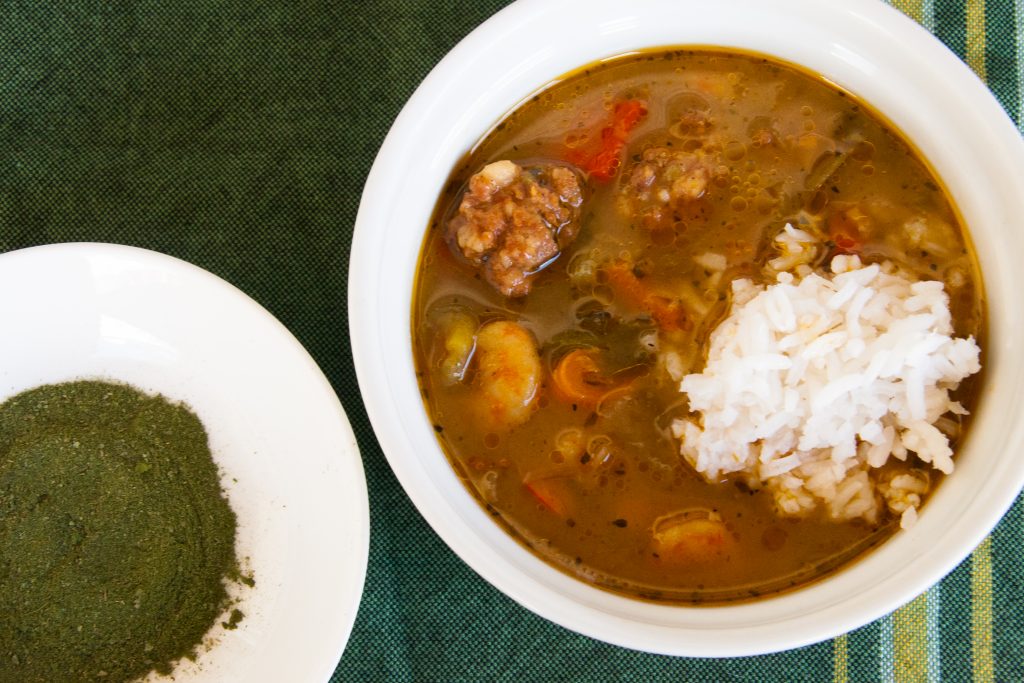
Although I’ve used sassafras twigs and roots for years, I’ve only recently started using the dried, ground leaves of sassafras, better known as filé. Yup, the filé in filé gumbo is dried, ground sassafras leaves. You can buy it in good spice stores, but if you’ve got access to sassafras trees, there’s no reason not to make your own foraged filé gumbo.
There are all kinds of gumbo recipes out there, some made with chicken, some with game meat, and some with beef, chicken, ham, and multiple types of sausage. Pork sausage and shrimp are my favorite combo.
I admit, I was a little intimidated by the idea of making a roux. Everything I read said constant stirring was required to avoid burning the roux and a burned roux is a ruined roux. Darker, heavier meats (like venison and beef) usually go with darker roux. For shrimp and pork, I decided on a slightly lighter roux, the color of peanut butter.
I swear to you, I watched it like a hawk and never stopped stirring, not for a second. And yet, the moment it turned the color of peanut butter, I could smell that it had burned. Damn, that happened fast. So I threw it out and started over again, this time cooking over lower heat. It’s tricky when instructions say “cook over medium heat” because burners are so variable. If you’re not sure how hot your burner is, err on the side of lower heat.
My second roux was successful. I stopped cooking just before reaching peanut butter color, which was perfect, because the roux continues to cook once you’ve added the vegetables.
One additional foraged ingredient: dock! Many gumbo recipes rely on okra for thickening. Not me. I don’t much care for okra, and besides, I intended the filé to be my primary thickener. But I had just harvested a nice batch of dock, which is pretty darn mucilaginous. So into the gumbo it went.
Note: sassafras foliage becomes more mucilaginous as the growing season progresses, but don’t wait too long. Leaves used for filé should be fresh and green. A good compromise time for me is usually the end of July, but your optimum harvest time will depend on your location. Dry the leaves in your dehydrator at 95F, and keep them whole until just before using, then grind them into a fine powder in a spice grinder.
What You’ll Need to Make Foraged Filé Gumbo
- 1/2 cup peanut oil
- 1/2 cup flour
- 1 red, 1 orange, 1 yellow pepper, chopped into bite sized pieces
- 1 large onion, chopped into bite sized pieces
- 1 tsp. black pepper
- 1/2 tsp. cayenne pepper
- 1 Tbs. ground celery seed
- 1 Tbs. ground bee balm (you may substitute oregano)
- 1 tsp. salt
- 1 1/2 CA bay leaves (or 3 regular bay leaves)
- 6 cups liquid (stock and water are both acceptable)
- 12 ounces of sausage, cut into bite sized pieces
- 1 lb. small shrimp
- 1 1/2 cup chopped dock
- filé powder (make your own by grinding dried sassafras leaves)
What You’ll Do to Make Foraged Filé Gumbo
Heat a heavy-bottomed pan and pour in the oil and flour. Whisk constantly as the flour browns. Don’t look away, not for a second. Keep the heat on medium-low and remove the pan from the heat AS SOON AS it has reached the right color brown. And really, if it smells even the tiniest bit burned, throw out the roux and start over.
Add the chopped peppers and onions to the roux and stir for five minutes, to soften the vegetables. Yes, this is another stage at which constant stirring is required. It really is worth it.
Add the black and cayenne peppers, the celery seed, bee balm, salt, and bay leaves, and stir to combine well.
Next, add the liquid. I had a quart of lobster stock on hand, so I used that plus 2 cups of water. A blend of chicken stock and water would also have been fine. Bring the mixture to a boil, add the sausage, and reduce the heat to a simmer, cooking for 30 minutes.
Add the shrimp and dock, and simmer for another five minutes.
At this point, many recipes ask you to add the filé powder and simmer for another few minutes. But I’ve always been told that in the very finest gumbo establishments, a shaker of filé is placed on the table and each person adds their own, thickening the broth according to their own personal preference.
Dish the gumbo into bowls, and invite each diner to stir in their own filé. When the soup has thickened, add rice and enjoy.
This recipe makes 6 – 8 servings, depending on how hungry you are.

Leave a Reply